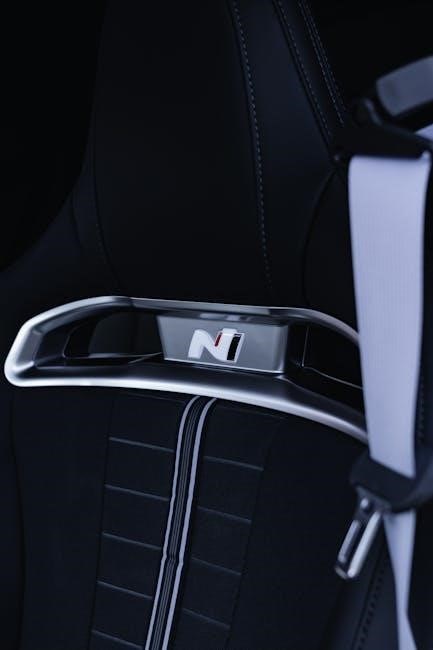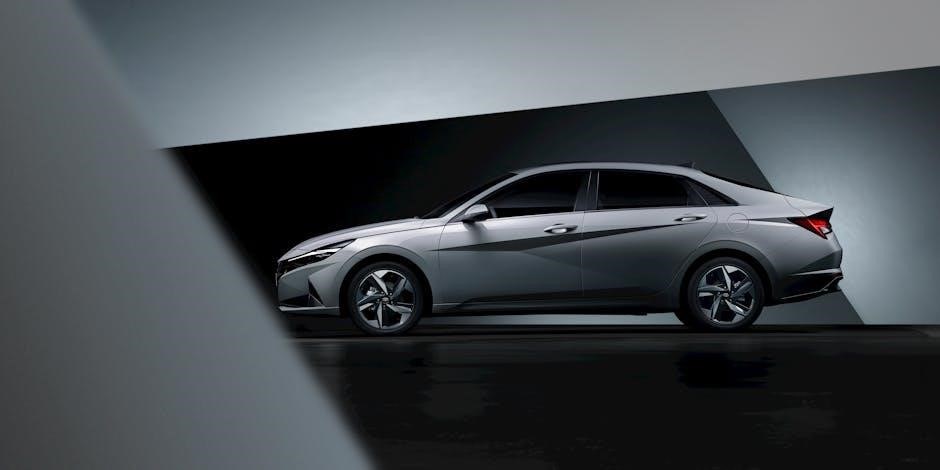Welcome to the 2018 Hyundai Elantra Owner’s Manual! This guide provides essential information for safe and efficient operation, maintenance, and troubleshooting of your vehicle.

1.1 Purpose of the Manual

The 2018 Hyundai Elantra Owner’s Manual is designed to help you understand and operate your vehicle safely and effectively. It provides detailed information about features, maintenance, and troubleshooting to ensure optimal performance. The manual also includes essential safety precautions and guidelines for proper vehicle care. By following the instructions and recommendations outlined in this guide, you can maximize your driving experience, maintain your car’s longevity, and ensure compliance with warranty conditions. This manual is your comprehensive resource for all aspects of Elantra ownership, helping you make informed decisions and enjoy a trouble-free driving experience.
1.2 Important Safety Information
The 2018 Hyundai Elantra Owner’s Manual emphasizes critical safety guidelines to protect you and your passengers. Always wear seatbelts, ensure proper child seat installation, and avoid distractions while driving. Familiarize yourself with airbag locations and their operation. Never modify safety systems or disable features like ABS or ESC, as they are crucial for vehicle control. Adhere to warning lights and alarms, addressing issues promptly. Proper vehicle maintenance is essential for safety; follow recommended schedules and inspections. By adhering to these precautions, you can minimize risks and ensure a secure driving environment. Safety should always be your top priority behind the wheel.
1.3 How to Use This Manual
This manual is organized into sections to help you quickly find the information you need. Start with the Table of Contents to navigate through topics like safety features, maintenance, and troubleshooting. Symbols are used throughout to highlight important information, such as warnings or cautions. Refer to the index at the end for quick access to specific terms or topics. Use the troubleshooting section to diagnose common issues and find solutions. Always read safety information carefully before operating or maintaining your vehicle. By following the guidelines in this manual, you can ensure optimal performance and longevity of your 2018 Hyundai Elantra.

Key Features of the 2018 Hyundai Elantra
The 2018 Hyundai Elantra offers a stylish exterior, advanced interior technology, and efficient performance. Its features include a modern design, comfortable seating, and innovative safety systems.
2.1 Exterior Design and Components
The 2018 Hyundai Elantra features a sleek and aerodynamic exterior design with a bold front grille, LED headlights, and a sporty rear bumper. The alloy wheels enhance its modern appeal. The body structure is built with high-strength steel for durability and safety. Exterior components include power-adjustable side mirrors, a shark-fin antenna, and a rear spoiler for improved aerodynamics. The vehicle is available in various color options, allowing owners to personalize their car. These design elements contribute to a refined and dynamic appearance, making the Elantra stand out on the road.
2.2 Interior Features and Technology
The 2018 Hyundai Elantra offers a comfortable and technologically advanced interior. Premium materials and ergonomic design ensure a refined driving experience. Key features include a touchscreen infotainment system with Apple CarPlay™ and Android Auto™ compatibility, Bluetooth connectivity, and a rearview camera for enhanced visibility. The cabin also features a leather-wrapped steering wheel, heated front seats, and dual-zone automatic climate control for personalized comfort. Optional upgrades include a power sunroof, wireless charging pad, and an 8-speaker Infinity premium audio system. The interior is designed to balance functionality and style, providing drivers with a modern and intuitive environment.
2.3 Engine and Performance Specifications
The 2018 Hyundai Elantra is powered by a 2.0-liter inline-4 cylinder engine, producing 147 horsepower and 132 lb-ft of torque. It features a multi-point fuel injection system for efficient combustion. Available transmissions include a 6-speed manual and a 6-speed automatic with SHIFTRONIC® for smooth shifting. The Sport model offers a 1.6-liter turbocharged inline-4 engine, delivering 201 horsepower and 195 lb-ft of torque, paired with a 6-speed manual or 7-speed dual-clutch transmission. The Elantra achieves an EPA-estimated 28 MPG city and 38 MPG highway for the base engine, while the turbocharged option slightly lowers fuel efficiency due to increased power.
2.4 Fuel Efficiency and Environmental Benefits
The 2018 Hyundai Elantra offers excellent fuel efficiency, with the base model achieving an EPA-estimated 28 MPG in the city and 38 MPG on the highway. The Sport model with the turbocharged engine provides slightly lower efficiency due to increased power. Eco-friendly features include an ECO mode that optimizes fuel consumption by adjusting transmission and engine settings. The Elantra also incorporates lightweight materials to reduce emissions and improve fuel economy. These enhancements contribute to a more environmentally responsible driving experience while maintaining performance and comfort.
Instrument Cluster and Controls
The instrument cluster displays essential driving information like speed and fuel level, while controls on the steering wheel and dashboard manage functions like cruise control and audio.
3.1 Dashboard Overview
The dashboard of the 2018 Hyundai Elantra is designed for functionality and ease of use. It features a central infotainment system with a touchscreen display, providing access to navigation, Bluetooth, and audio controls. The instrument cluster includes a speedometer, tachometer, and fuel gauge, offering clear visibility of essential driving information. Additional controls for heating, ventilation, and air conditioning are conveniently located below the infotainment screen. The dashboard also includes cup holders, USB ports, and storage compartments for added convenience. The layout is intuitive, ensuring drivers can easily access all necessary functions while maintaining focus on the road.
3.2 Gauges and Warning Lights
The 2018 Hyundai Elantra features a comprehensive set of gauges and warning lights designed to keep you informed about your vehicle’s status. The speedometer, tachometer, fuel gauge, and temperature gauge provide essential driving information. Warning lights, such as the oil pressure, battery, and ABS indicators, illuminate when a system requires attention. The check engine light alerts you to potential engine issues, while the ESC and traction control lights indicate system activation. The manual details each light’s meaning and recommended actions. Always monitor these indicators and consult the manual or a Hyundai service center if a light persists or flashes unexpectedly.
3.3 Steering Wheel Controls

The 2018 Hyundai Elantra’s steering wheel features integrated controls for enhanced convenience and safety. On the left side, you’ll find buttons for cruise control, allowing you to set and adjust speed effortlessly. The right side includes audio controls for volume adjustment, track selection, and playback options. Additionally, buttons for hands-free phone operation and voice command are located on the wheel, enabling seamless interaction with the infotainment system. These controls ensure you can manage key functions without taking your hands off the wheel, promoting safer and more comfortable driving. Familiarize yourself with these buttons to optimize your driving experience.
Safety Features and Precautions
The 2018 Hyundai Elantra prioritizes safety with advanced systems like Forward Collision-Avoidance Assist and Lane Keeping Assist. Multiple airbags and a rigid body structure enhance occupant protection. Always follow safety guidelines to minimize risks and ensure proper function of safety features.
4.1 Airbags and Seatbelts
The 2018 Hyundai Elantra is equipped with a comprehensive airbag system, including front, side, and curtain airbags to protect occupants in various collision scenarios. Seatbelts feature a 3-point system for all seating positions, with pretensioners that tighten during sudden stops or collisions. The seatbelt indicator on the instrument cluster alerts drivers if any seatbelt is unfastened. Always ensure all occupants wear seatbelts correctly to maximize safety. The airbag system works in conjunction with seatbelts to provide optimal protection. Never modify or disable airbags, as this can compromise safety. Refer to the manual for proper maintenance and troubleshooting of these systems.
4.2 Electronic Stability Control (ESC)
The 2018 Hyundai Elantra features an advanced Electronic Stability Control (ESC) system designed to enhance vehicle stability and control. ESC automatically adjusts engine power and applies selective braking to individual wheels when the vehicle detects a loss of traction or skidding. This system operates seamlessly in the background, especially during sharp turns or slippery road conditions. The ESC is integrated with other safety systems like ABS for optimal performance. A dashboard warning light indicates if ESC is active or if there’s a system malfunction. For off-road driving, ESC can be manually deactivated, though this is not recommended for normal driving conditions. Always refer to the manual for proper operation and troubleshooting.
4.3 Anti-Lock Braking System (ABS)
The 2018 Hyundai Elantra is equipped with an Anti-Lock Braking System (ABS) to improve braking performance and prevent wheel lock-up during hard braking or slippery conditions. ABS rapidly pulses the brakes to maintain tire traction, helping the driver maintain control and avoid skidding. A speed sensor monitors wheel rotation, and the system activates automatically when necessary. A dashboard warning light illuminates if ABS malfunctions. For optimal function, avoid abruptly releasing the brake pedal during ABS activation. Regular maintenance, such as inspecting brake pads and rotors, ensures ABS operates effectively. This system is a critical component of the Elantra’s advanced safety features.
4.4 Child Safety Features
The 2018 Hyundai Elantra incorporates advanced child safety features to protect young passengers. The rear seat includes child safety door locks, preventing children from opening the doors while the vehicle is moving. ISOFIX anchors are provided for secure installation of child seats. A seatbelt reminder system alerts drivers if rear seat passengers are not buckled up. Additionally, a rear seat alarm sounds if a door is opened while the vehicle is in motion. Always ensure children are properly restrained and never left unattended in the car. These features enhance safety and provide peace of mind for families on the go.

Driving Information and Tips
Optimize your driving experience with smooth acceleration and gear shifting. Maintain a safe distance and adjust speed according to road conditions. Use cruise control on highways for convenience and fuel efficiency. Avoid sudden maneuvers and ensure proper vehicle maintenance for enhanced performance and safety. Familiarize yourself with the vehicle’s features to maximize comfort and control during your journey.
5.1 Starting and Stopping the Engine
To start the engine, ensure the transmission is in park (automatic) or first gear (manual). Press the brake pedal firmly, then turn the ignition key or press the start button. For push-button start, ensure the key fob is inside the vehicle. The engine will start automatically. To stop the engine, come to a complete stop, shift into park (automatic) or first gear (manual), and press the ignition button or turn the key to the “OFF” position. Always engage the parking brake for safety. Avoid sudden starts or stops to maintain control and ensure passenger comfort.
5.2 Transmission and Gear Shifting
For smooth operation, use the transmission and gear shifting correctly. In automatic models, shift into “D” for forward motion and “R” for reversing. Manual models require clutch pedal use; press fully before shifting gears. Avoid riding the clutch or brake to prevent wear. Use the gearshift smoothly, ensuring gears align properly. In automatics, manual shift mode (if equipped) allows gear selection via the shifter. Always come to a complete stop before reversing or shifting directions. Proper shifting enhances fuel efficiency, performance, and longevity of the transmission. Refer to the gearshift diagram in your manual for guidance.
5.3 Driving in Various Conditions
Adapt your driving to weather and road conditions for safety. In rain or snow, reduce speed and increase following distance. Avoid sudden acceleration or braking. Use fog lights in low visibility and windshield wipers in rain; For icy roads, maintain gentle control inputs. In extreme heat, use sunglasses and stay hydrated. When driving uphill, maintain a steady speed and avoid riding the brakes. Downshift before descending steep hills to control speed. Always use headlights in poor visibility. Familiarize yourself with your Elantra’s features, like traction control, to enhance stability in challenging conditions. Safe driving requires adjustments based on the environment.

Maintenance and Care
Regular maintenance ensures optimal performance. Check fluids, belts, and tires monthly. Keep exterior and interior clean. Use genuine parts. Follow the recommended schedule and keep records.
6.1 Scheduled Maintenance Intervals
Regular maintenance is essential for your Hyundai Elantra’s longevity. Follow the recommended schedule in your manual, typically every 7,500 miles. This includes oil changes, tire rotations, and inspections of belts, hoses, and fluids. Neglecting these intervals can lead to reduced performance, fuel efficiency, or even damage. Always use genuine Hyundai parts to ensure compatibility and reliability. Keep a maintenance log to track services and stay on schedule. Proper care extends the life of your vehicle and maintains its warranty coverage. Refer to the manual for specific details on each service interval.
6.2 Oil and Fluid Checks
Regular oil and fluid checks are vital for your Hyundai Elantra’s health. Check engine oil level using the dipstick, ensuring it’s between the “MIN” and “MAX” marks. Coolant, brake, and windshield washer fluids should also be inspected regularly. Always use the recommended fluid types to avoid damage. Check fluid levels when the engine is cold for accuracy. Overfilling can harm engine performance. If levels are low, top up as needed. Refer to your manual for reservoir locations and specifications. Address any leaks or discrepancies promptly. Proper fluid maintenance ensures optimal performance and prevents costly repairs.
6.3 Tire Pressure and Rotation
Proper tire pressure and rotation are essential for safety, fuel efficiency, and tire longevity. Check tire pressure monthly and before long trips using a reliable gauge. Refer to the owner’s manual or the tire information label on the driver’s side doorjamb for the recommended pressure. Under-inflation can lead to poor handling and increased wear. Rotate tires every 5,000 to 8,000 miles, following the pattern in your manual. Uneven tread wear may indicate misalignment. Regular rotation ensures even wear and extends tire life. Always maintain correct pressure for optimal performance and safety on the road.

Troubleshooting Common Issues
This section helps owners identify and resolve common problems with their 2018 Hyundai Elantra. It provides step-by-step guidance for diagnosing issues like warning lights or unusual noises.
7.1 Diagnosing Warning Lights
The 2018 Hyundai Elantra features a comprehensive warning light system to alert drivers of potential issues. This section explains how to identify and interpret these lights, such as the check engine light, ABS light, or battery alert. It provides guidance on understanding the color coding (red, yellow, green) and what actions to take when a light illuminates. Drivers are advised to stop the vehicle safely if a red light appears and consult the manual or a certified technician for further assistance. Regular checks and addressing warnings promptly help ensure vehicle reliability and safety.
7.2 Solving Common Problems
This section provides practical solutions for common issues Elantra owners may encounter, such as low battery, Bluetooth connectivity problems, or unusual noises during acceleration. It offers step-by-step guidance for troubleshooting and resolving these issues, emphasizing safety and proper diagnostic techniques. Owners are encouraged to consult the manual or contact a Hyundai service center if problems persist. Regular maintenance and timely repairs are stressed to prevent minor issues from becoming major concerns. By addressing common problems effectively, drivers can ensure optimal performance and longevity of their vehicle.

Warranty and Service Information
The 2018 Hyundai Elantra comes with a comprehensive warranty program, including coverage for parts and labor. Schedule service appointments at authorized dealerships for genuine maintenance and repairs.
8.1 New Vehicle Warranty Coverage
The 2018 Hyundai Elantra is backed by a comprehensive warranty program. The New Vehicle Limited Warranty provides coverage for 5 years or 60,000 miles, with no mileage limitation for the first year. The powertrain is covered for 10 years or 100,000 miles, offering extended protection for critical components like the engine and transmission. Additional benefits include 5 years of roadside assistance and 7 years of anti-perforation warranty for the body. Proper maintenance at authorized Hyundai service centers ensures warranty validity and enhances resale value. Refer to the manual for full terms and conditions.

8.2 Scheduling Service Appointments
To maintain your 2018 Hyundai Elantra, schedule service appointments through Hyundai’s online portal or by calling your local dealership. Use the owner’s portal to select preferred dates and times. Provide your vehicle’s VIN for personalized service. You can also use the Hyundai mobile app for convenience. Regular servicing ensures optimal performance, safety, and warranty compliance; Dealerships may offer notifications for upcoming maintenance. Always confirm your appointment and review service details before arrival. Proper scheduling helps prevent delays and ensures your Elantra remains in peak condition.
The 2018 Hyundai Elantra Owner’s Manual provides essential guidance for optimal vehicle performance and longevity. Follow its tips for regular maintenance, understanding features, and troubleshooting to ensure a safe and reliable driving experience.
9.1 Final Tips for Elantra Owners
Regularly check and maintain your Elantra’s engine, tires, and fluids to ensure peak performance. Practice safe driving habits, such as smooth acceleration and braking, to extend the vehicle’s lifespan. Keep the interior clean and protect it from extreme temperatures. Familiarize yourself with advanced features like cruise control and Bluetooth for a more enjoyable driving experience. Stay updated on software and firmware updates for optimal functionality. Always refer to the manual for specific guidance, and keep a record of maintenance and repairs. By following these tips, you’ll maximize your Elantra’s reliability and enjoy a satisfying ownership experience for years to come.
